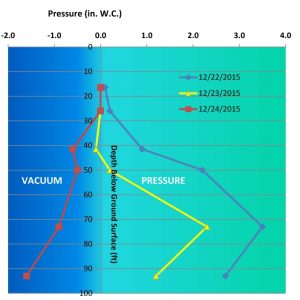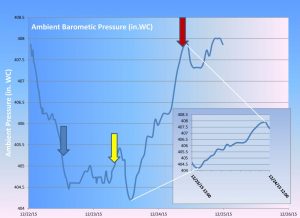This is the first in a series of articles we are calling “Technical Notes” that we will publish a few times a year to share science and engineering principles applicable to remediation. Subscribe to this blog to automatically receive updates in your email.
Technical Note: Are those vacuum data real?

by Gordon Alexander, P.E.
One warm winter afternoon in Phoenix, Arizona I was fascinated when I felt air “exhaling” from the open mouth of a 4-inch soil vapor extraction (SVE) well that had been installed to a depth of 110 feet. We could balance ping-pong balls on the steady air stream coming from the well. Unusual results are often encountered while collecting subsurface vacuum/pressure data for SVE, bioventing and vapor intrusion studies.
 On December 22, 2015, during a three-day SVE test event, we observed positive pressures in monitoring points located at a distance from the extraction well. Measured pressures relative to atmospheric pressure (called gauge pressures) (see blue line) ranged as high as 3.5 inches water column (in.WC) in the six monitoring points constructed to a depth of 100 feet! (see Figure left). When measured again on December 23 (see yellow line), the positive pressures were falling. On the last test day, December 24, we observed vacuums in all the monitoring probes with the deepest probe having the highest vacuum. Why?
On December 22, 2015, during a three-day SVE test event, we observed positive pressures in monitoring points located at a distance from the extraction well. Measured pressures relative to atmospheric pressure (called gauge pressures) (see blue line) ranged as high as 3.5 inches water column (in.WC) in the six monitoring points constructed to a depth of 100 feet! (see Figure left). When measured again on December 23 (see yellow line), the positive pressures were falling. On the last test day, December 24, we observed vacuums in all the monitoring probes with the deepest probe having the highest vacuum. Why?
The reason for the changes in detected vacuum can be found in the atmospheric barometric pressures during the test, below. A weather front blew through the area on December 22 dominating the weather and delivering low barometric pressures until the 23rd. The barometric pressure soared 4 in.WC from noon on the 23rd until noon on the 24th. In the final analysis, the pressures measured on December 22 were a result of the rapid drop in barometric pressure while the vacuums measured on December 24 were a result of the rapid increase. Any vacuums induced by the SVE well were masked by these larges shifts in pressure.

So, be sure to keep track of the barometric pressure and avoid testing during changing weather conditions. Even changing the time of day for data collection can have a big impact on monitoring results.
This pressure variation can even be used to provide long-term oxygenation of the subsurface at passive remedy sites for petroleum hydrocarbons and chlorinated solvents. We’ll investigate this in an upcoming technical blog.
SIGN UP!
If you are interested in more information on Kennedy Jenks, don’t forget to subscribe to our blog!

